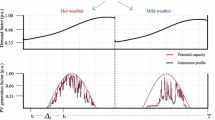Abstract
The deployment of batteries in the distribution networks can provide an array of flexibility services to integrate renewable energy sources (RES) and improve grid operation in general. Hence, this paper presents the problem of optimal placement and sizing of distributed battery energy storage systems (DBESSs) from the viewpoint of distribution system operator to increase the network flexibility. The problem is formulated as an optimization framework wherein the objective function is to minimize the annualized sum of investment costs and operational costs of DBESSs while it is constrained to power flow, DBESS and RES constraints as well as distribution network operation limits. In addition, while the problem model is as nonlinear programming, this paper suggests an equivalent linear programming model for all constraints and quadratic formulation for the objective function to reach the global optimal solution with low error calculation. In the next step, the Benders decomposition approach is deployed to acquire better calculation speed. Finally, the proposed problem is applied to 19-bus LV CIGRE benchmark grid by GAMS software to investigate the capability of the model.














Similar content being viewed by others
Abbreviations
- (b,j), t, l, k :
-
Indices of bus, time, linearization segments of voltage magnitude term and circular constraint, respectively
- m, nf :
-
Index and total number of the iterations of the primal sub-problem to be feasible, respectively
- r, ni :
-
Index and total number of the iterations of the primal sub-problem to be infeasible, respectively
- φb, φt, φl, φk :
-
Sets of bus, time, linearization segments of voltage magnitude term and circular constraint, respectively
- A :
-
Bus incidence matrix (if line existed between buses b and j, Ab,j is equal to 1, and 0 otherwise)
- A min :
-
Minimum boundary rate of the stored energy of battery
- c s :
-
Annual investment cost (in $/MWh/year)
- g, b :
-
Line conductance and susceptance in per unit (pu), respectively
- N s :
-
Total number of storage systems
- Pch-max, Pdis-max :
-
Maximum charging and discharging rate of battery in pu, respectively
- PD, QD :
-
Active and reactive load in pu, respectively
- PV:
-
Output power of photovoltaic in pu
- SGmax, SLmax :
-
Maximum loading of distribution line and station in pu, respectively
- T :
-
Operating horizon, i.e., 6, 12, 24 or 48 h
- Vmax, Vmin :
-
Maximum and minimum voltage magnitude in pu, respectively
- V ref :
-
Voltage of reference (station) bus in pu
- ω max :
-
Maximum capacity of battery in pu
- ηch, ηdis :
-
Efficiency parameter for charging and discharging of the battery, respectively
- λch, λdis :
-
Charging and discharging price of the battery, respectively, in $/MWh
- E :
-
Stored energy of battery
- Pch, Pdis :
-
Amount of electricity charged and discharged from battery
- PG, QG :
-
Active and reactive power of the station, respectively
- PL, QL :
-
Active and reactive power of lines, respectively
- V, ΔV, θ :
-
Magnitude, deviation and angle of voltage (in rad), respectively
- ω :
-
Capacity of battery
- λsub, μsub :
-
Dual variables of equality and inequality constraints in the primal sub-problem
- Jp, Jsub :
-
Master problem and sub-problem objective functions
References
Benders JF (1962) Partitioning procedures for solving mixed-variables programming problems. Numer Math 4(1):238–252
Bjarghov SN, Utilizing EV (2017) Batteries as a flexible resource at end-user level, in electric power engineering. Master Thesis, Norwegian University of Science and Technology (NTNU)
Bucciarelli M, Paoletti S, Vicino A (2018) Optimal sizing of energy storage systems under uncertain demand and generation. Appl Energy 225:611–621
Bucher C, Andersson G (2012) Generation of domestic load profiles—an adaptive top-down approach. In: Proceedings of PMAPS 2012, Istanbul, Turkey
Cervantes J, Choobineh F (2018) Optimal sizing of a nonutility-scale solar power system and its battery storage. Appl Energy 216:105–115
Conejo AJ, Castillo E, Minguez R, Garcid-Bertrand R (2006) Decomposition techniques in mathematical programming. Springer, Berlin
Eurelectric (2014) Flexibility and aggregation requirements for their interaction in the market. https://www.usef.energy/app/uploads/2016/12/EURELECTRIC-Flexibility-and-Aggregation-jan-2014.pdf. Accessed Aug 2019
Fortenbacher P, Ulbig A, Andersson G (2017) Optimal placement and sizing of distributed battery storage in low voltage grids using receding horizon control strategies. IEEE Trans Power Syst 33(3):2383–2394
Fraizzoli D (2017) Methodology to estimate the flexibility potential of an aggregator’s portfolio in a residential distribution grid. Available online. https://upcommons.upc.edu/handle/2117/109780. Accessed Feb 2018
Generalized Algebraic Modeling Systems (GAMS). [Online] http://www.gams.com
Grover-Silva E, Girard R, Kariniotakis G (2018) Optimal sizing and placement of distribution grid connected battery systems through an SOCP optimal power flow algorithm. Appl Energy 219:385–393
Jannesar MR, Sedighi A, Savaghebi M, Guerrero JM (2018) Optimal placement, sizing, and daily charge/discharge of battery energy storage in low voltage distribution network with high photovoltaic penetration. Appl Energy 226:957–966
Khalid Mehmood K, Khan SU, Lee SJ, Haider ZM, Rafique MK, Kim CH (2017) Optimal sizing and allocation of battery energy storage systems with wind and solar power DGs in a distribution network for voltage regulation considering the lifespan of batteries. IET Renew Power Gener 11(10):1305–1315
Lloret P, Olivella P (2017) INVADE architecture of pilots, INVADE project
Malvoni M, Giorgi MGD, Congedo PM (2016) Data on photovoltaic power forecasting models for Mediterranean climate. Data Brief 7:1639–1642
Meechaka A, Sangswang A, Kirtikara K, Chenvidhya D (2017) Optimal location and sizing for PV system and battery energy storage system using ABC algorithm considering voltage deviation and time of use rate. In: 9th International conference on information technology and electrical engineering (ICITEE), Phuket, pp 1–6
Nasrolahpour E, Kazempour SJ, Zareipour H, Rosehart WD (2016) Strategic sizing of energy storage facilities in electricity markets. IEEE Trans Sustain Energy 7(4):1462–1472
Nord Pool https://www.nordpoolgroup.com/historical-market-data/
Pandzic H, Wang Y, Qiu T, Dvorkin Y, Kirschen DS (2015) Near-optimal method for siting and sizing of distributed storage in a transmission network. IEEE Trans Power Syst 30(5):2288–2300
Pirouzi S, Aghaei J (2018) Mathematical modeling of electric vehicles contributions in voltage security of smart distribution networks. Trans Soc Model Simul Int (in press)
Pirouzi S, Aghaei J, Shafie-khah M, Osório GJ, Catalão JPS (2017a) Evaluating the security of electrical energy distribution networks in the presence of electric vehicles. In: Proceedings on PowerTechnology conference IEEE Manchester, pp 1–6
Pirouzi S, Aghaei J, Latify MA, Yousefi GR, Mokryani G (2017b) A robust optimization approach for active and reactive power management in smart distribution networks using electric vehicles. IEEE Syst J 1–12
Pirouzi S, Aghaei J, Niknam T, Shafie-khah M, Vahidinasab V, Catalão JPS (2017c) Two alternative robust optimization models for flexible power management of electric vehicles in distribution networks. Energy 141:635–652
Pirouzi S, Aghaei J, Vahidinasab V, Niknam T, Khodaei A (2018a) Robust linear architecture for active/reactive power scheduling of EV integrated smart distribution networks. Electr Power Syst Res 155:8–20
Pirouzi S, Aghaei J, Niknam T, Farahmand H, Korpås M (2018b) Proactive operation of electric vehicles in harmonic polluted smart distribution networks. IET Gener Trans Distrib 12:967–975
Qiu J, Zhao J, Yang H, Wang D, Dong ZY (2018) Planning of solar photovoltaics, battery energy storage system and gas micro turbine for coupled micro energy grids. Appl Energy 219:361–369
Saboori H, Hemmati R, Sadegh Ghiasi SM, Dehghan S (2017) Energy storage planning in electric power distribution networks—a state-of-the-art review. Renew Sustain Energy Rev 79:1108–1121
Sedghi M, Ahmadian A, Aliakbar-Golkar M (2016) Optimal storage planning in active distribution network considering uncertainty of wind power distributed generation. IEEE Trans Power Syst 31(1):304–316
Sisternes FJ, Jenkins JD, Botterud A (2016) The value of energy storage in decarbonizing the electricity sector. Appl Energy 175:368–379
Thrampoulidis C, Bose S, Hassibi B (2016) Optimal placement of distributed energy storage in power networks. IEEE Trans Autom Control 61(2):416–429
Wogrin S, Gayme DF (2015) Optimizing storage siting, sizing, and technology portfolios in transmission-constrained networks. IEEE Trans Power Syst 30(6):3304–3313
Wood AJ, Wollenberg BF (1996) Power generation, operation and control. Wiley, New York
Zhang Y, Dong ZY, Luo F, Zheng Y, Meng K, Wong KP (2016) Optimal allocation of battery energy storage systems in distribution networks with high wind power penetration. IET Renew Power Gener 10(8):1105–1113
Zhang Y, Ren S, Dong ZY, Xu Y, Meng K, Zheng Y (2017) Optimal placement of battery energy storage in distribution networks considering conservation voltage reduction and stochastic load composition. IET Gener Trans Distrib 11(15):3862–3870
Zheng Y, Dong ZY, Luo FJ, Meng K, Qiu J, Wong KP (2014) Optimal allocation of energy storage system for risk mitigation of DISCOs with high renewable penetrations. IEEE Trans Power Syst 29(1):212–220
Zidar M, Georgilakis PS et al (2016) Review of energy storage allocation in power distribution networks: applications, methods and future research. IET Gener Trans Distrib 10:645–652
Acknowledgements
Parts of the research leading to these results have received funding from the European Union under the Horizon2020 Framework Programme, Grant agreement No. 731148 (INVADE H2020 Project).
Author information
Authors and Affiliations
Corresponding author
Rights and permissions
About this article
Cite this article
Aghaei, J., Bozorgavari, S.A., Pirouzi, S. et al. Flexibility Planning of Distributed Battery Energy Storage Systems in Smart Distribution Networks. Iran J Sci Technol Trans Electr Eng 44, 1105–1121 (2020). https://doi.org/10.1007/s40998-019-00261-z
Received:
Accepted:
Published:
Issue Date:
DOI: https://doi.org/10.1007/s40998-019-00261-z




